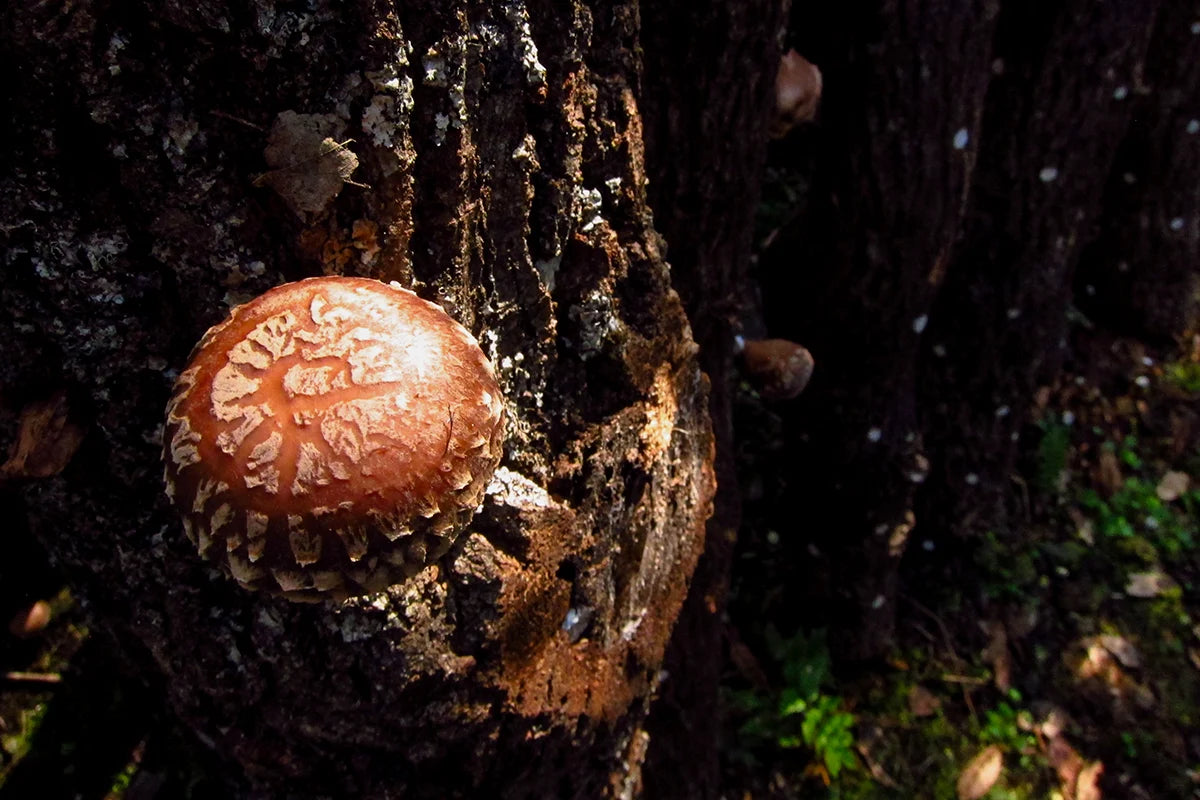
Having lived in Japan for many years, Thom Harrison knows a thing or two about Japanese ingredients and writes regularly about them on his website wagashi.uk. Here he walks us through the fungal world of the mighty shiitake mushroom.
Shiitake have been a cornerstone of Japanese cuisine for centuries, prized for their umami depth — that deep, brothy taste that lingers on the tongue and adds savoury oomph to dishes. The potential of this mushroom extends far beyond traditional Japanese cuisine, however, with exciting possibilities in Western kitchens.
Tell you the truth: I’d never been entirely sold on mushrooms. Since childhood, they were the one ingredient most likely to be pushed aside and left ostracised come the end of any meal.
It’s something about the texture. When stewed, regular button mushrooms act like a sponge. Boiling draws out the intensity of the mushroominess, while absorbing everything else. Frying tends to go the other way and sabotage the pan with a release of excess water.
Little did I know there would be a hero waiting in the wings ready to transform my perception of the entire mushroom kingdom: the mighty Shiitake. So much so that, for me, these are the only mushrooms to be enjoyed straight-up — flame-grilled, as they are, with just a sprinkle of salt.
This is one of the most popular ways you will find Shiitake served at street food vendors and Yakitori-ya all over Japan — a kind of pub specialising in grilled skewers. While "Yaki-Tori” loosely translates as “grilled poultry”, these pubs grill up all sorts of ingredients on skewers, known more broadly as Kushi-yaki.
It was in a Yakitori-ya that I had my mushroom epiphany. With a firm texture and intense, bold, meaty depth, Shiitake aren't your average supermarket whites.
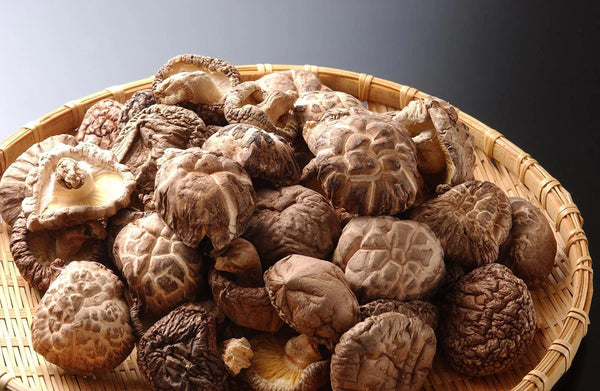
All about Shiitake
These gourmet mushrooms are renowned for their depth of flavour, and a big part of that comes from a particular amino acid called glutamate. This is key to what forms a sense of the fifth taste, known as umami — another Japanese word we’ve needed to adopt for English.
Umami is the taste you get from things like MSG, cured meats, and aged cheeses. We might call it savoury, but then, this word has a closer meaning to ‘not-sweet’ and doesn’t quite capture it.
Shiitake are larger than white button mushrooms and generally (but not always) smaller than portobellos. They’re recognisable by their dark brown, umbrella-shaped caps, typically 2-4 inches in diameter.
The texture is firm, meaty, with a slightly rough, almost woody stem. The caps may have a lighter, whitish veil around the edges when young. Underneath, you'll find pale gills that run down the stalk. They are classified under the phylum Basidiomycota, with spores on the cap underside, which means they’re also related to portobellos and chanterelles.
Cultivation
Cultivated for over a thousand years, this gourmet fungi holds a special place in Japan. Native to East Asia, the mushrooms were first documented in 7th century China, where they were enjoyed by the elite and as part of Buddhist temple cooking.
In the wild, Shiitake grow on decomposing logs and they’re cultivated on wood logs even today. Forest-grown woodland delicacies grows slowly, when cold winds and natural sunlight quickly dried moisture provided by rain and fog. Each has its own unique climatic exposure, producing myriad shapes and colours.
Over time, Shiitake cultivation spread throughout Asia. In 1796, a Japanese horticulturalist named Sato Churyo penned a well-known guide on cultivating the Japanese mushrooms, setting down established techniques.
Shozaburo Minura, a renowned mycologist (fungi specialist), devised a method of inoculating natural logs with Shiitake mycelial culture in 1914, revolutionising mushroom cultivation.
Donko Shiitake are the younger siblings of the regular 'shrooms. Smaller and rounder with a closed cap, they're picked before fully blooming. This gives them an even more intense umami flavour.
Today, the fungi are cultivated worldwide. Many would say the best still come from the main mushroom-producing region of Kyushu in southern Japan. Oita, Miyazaki, and Kumamoto produce 70% of the nation’s shiitake crop.
Sugimoto Premium Forest-Grown dried Shiitake
Sugimoto is renowned both in Japan and overseas for cultivating the highest quality forest-grown Shiitake.
Steeped in tradition, the mushrooms are harvested in the Kyushu region using traditional methods. Sugitomo's Shiitake are allowed to grow on logs of Sawtooth Oak trees. This oak is believed to produce the most flavourful and textured shiitake.
Forest-grown Shiitake like Sugimoto's are said to have a more intense umami flavour compared to sawdust-grown varieties. This is because they develop with more guanylate, which interacts with glutamate (another umami compound) to create a stronger flavour. The result is a mushroom with a deep profile and a firm texture, perfect for adding depth to all sorts of dishes.
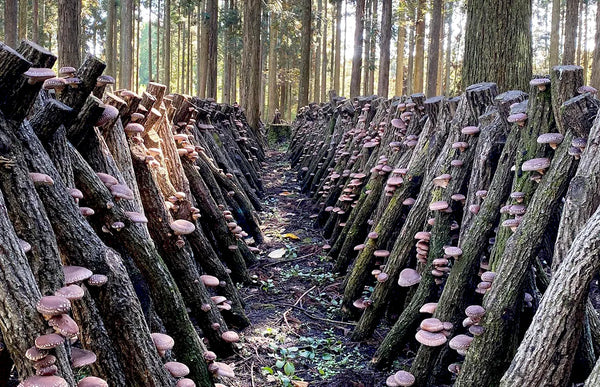
The Sugimoto family has a long tradition of growing Shiitake using natural and sustainable practices without pesticides or artificial chemicals. Even the oak trees used for growing are allowed to regenerate after harvest.
While honouring tradition, Sugimoto make use of modern technology during the final drying process. A far-infrared method gently preserves the mushrooms' natural integrity, ensuring you experience the full depth of their umami flavour and firm texture.
Nutrition
Lentinula edodes (that's the scientific name) have been used in traditional medicine for centuries and have garnered a reputation for being good for the immune system.
Shiitake contain polysaccharides, which are complex sugars that some research suggests can stimulate white blood cells. Some studies have investigated compounds in shiitake called eritadenine and beta-glucans, which may help lower cholesterol levels.
Like most mushrooms, they're are a good source of dietary fibre and a great source of B vitamins like riboflavin and niacin. Shiitake becomes rich in Vitamin D through exposure to sunlight (rather like we do) during growth. They also offer essential minerals like potassium and selenium to keep your body functioning at its best.
In Nabe: Japanese Hot Pot
One of the finest ways to enjoy Shiitake is in a nabe. The heart and soul of Japanese winter comfort food, nabe more or less translates into English as ‘Japanese-style hot pot’ and can be made with all kinds of meat, mushrooms, and vegetables.
The broth, too, can be made from all sorts of bases, most typically soy, dashi, and miso. These broths all tend to be fairly light and delicate (more a consommé than a stew).
Sukiyaki is a variety of Nabe featuring thinly sliced beef, mushrooms, vegetables, and tofu cooked in a soy sauce broth with mirin and sake. Mirin is a sweeter sort of rice wine with a lower alcohol content than Sake and often used in sauces as you might a spoonful of brown sugar.
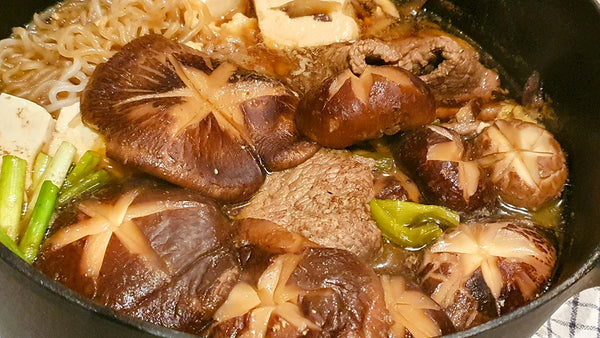
One major difference between Japanese and Western hot pots is that the Japanese tend to slice the meat very very thinly, to be dropped in at the end only moments before serving. Ordering Nabe at a restaurant, the raw meat is placed on the table for you to complete this step yourselves.
Shabu Shabu is another famous type of nabe that always features thinly sliced meat, which you dip into the broth placed at the centre of the table ("shabu shabu" describes the dipping and swishing motion). You can even order two or three different sorts of broth in a divided pot.
Sliced Shiitake caps absorb the broth more readily, becoming tender and infused with its aromatic flavours.
The star-shaped pattern sliced on the tops of Shiitake mushrooms is called ‘Hoshigiri’ (we might call it "cross-hatching"). This looks attractive while promoting even-cooking with surface area exposure.
As the hot pot simmers, the mushrooms release their earthy aroma, enhancing the overall sensory experience. Additionally, Shiitake mushrooms complement other ingredients commonly found in Nabe, such as tofu, vegetables, and thinly sliced meats, creating a harmony of flavours and textures.
Shiitake in Non-Japanese Cuisine
Shiitake make an appearance in lots of other Asian cuisines. In Korea, Shiitake are used in Beoseot Jeongol (mushroom hotpot) or the classic kimchi chigae (kimchi hotpot).
Then again, there’s nothing exclusively oriental about the Shiitake flavour — they work just as well in Western dishes, be that stroganoff or cream fettuccine, fried up with steak, wrapped in tortillas — you name it.
Vegetarians love them for their meaty bite in broths and sauces. Shiitake brings umami depth to all sorts of vegetarian or vegan dishes — be that veggie bolognese, mushroom risotto, chilli non-carne, and so on.
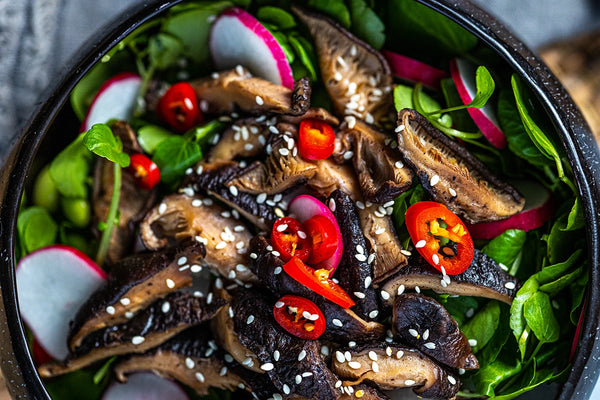
If you’re aiming for Japanese flavours, though, I’d steer well clear of coriander or lime (unlike certain high street chains in the UK) as this really has nothing whatsoever to do with authentic Japanese food!
Using Dried Shiitake
Dried Shiitake mushrooms are a fantastic pantry staple for adding an intense umami punch to your cooking. This was, in fact, a common method for preserving food in historical Japan.
Drying condenses all the flavour of fresh Shiitake into a smaller package. While the fresh mushrooms stay good for a week or two, dried Shiitake can last for up to a year if stored properly in a cool, dark place. So they’re a great option for keeping delicious mushrooms on hand whenever a recipe calls for them.
One amazing thing about dried Shiitake is how, after soaking the mushrooms in water, this draws out all the concentrated flavours and aromas within the dried flesh. With no effort at all you’re left with the most incredible chestnut-brown mushroom stock. (This week I had a nabe on Sunday and used the stock for a mushroom risotto on Monday).

How to rehydrate Shiitake mushrooms
Dried Shiitake generally needs to be reconstituted before use. For the best flavour and texture, soak the shiitake for at least four hours, or ideally overnight.
Rinse: Briefly rinse the dried Shiitake under cool running water to remove any dirt or debris.
Submerge: Place the Shiitake in a resealable zipper bag, or a covered bowl, with cool water. It might not matter how much water you use, but if you want to be left with a good shiitake stock (which you should) a general rule of thumb is a cup for every 4-5 medium-sized shiitake caps used.
Soak Time: Patience is key! For the best flavour and texture, soak the Shiitake for at least 6-8 hours, or ideally overnight. Soaking in the fridge overnight is a great option, especially in warmer weather.
Keep the stock!: The soaking liquid becomes full of umami flavour. Strain it with sieve and hold on to it as a stock for soups, stews, risottos, or anything else you fancy.
Enjoy! Once fully hydrated, the Shiitake are ready to use in your recipe. Slice or chop the caps depending on the dish. The stems should be finely chopped into small pieces or used to add flavour to a broth.
Dried Shiitake Powder
A recent innovation even in Japan, grating the dried mushrooms onto dishes is a simple way to add umami and depth. Think of it as the truffle of the mushroom world – each shaving adds an explosion of umami to rival more expensive ingredients.
Beyond just umami, dried Shiitake powder offers an earthy, woodsy complexity that adds depth and intrigue to your food. It's like a flavour shortcut, instantly transforming simple dishes into restaurant-worthy creations. Start with a small amount and adjust to taste. Remember, a little goes a long way!
This can be used in a wide variety of dishes. Think soups, stews, sauces, gravies, stir-fries, pasta – the possibilities are endless! For vegetarians and vegans seeking a rich, savoury flavour without meat, dried Shiitake powder adds depth and complexity to plant-based dishes.

